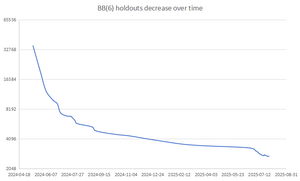BB(6)
The 6-state, 2-symbol Busy Beaver problem, BB(6), refers to the unsolved 6th value of the Busy Beaver function. With the discovery of the Cryptid machine Antihydra in June 2024, we now know that we must solve a Collatz-like problem in order to solve BB(6) and thus BB(6) is Hard.
The current BB(6) champion 1RB1RA_1RC1RZ_1LD0RF_1RA0LE_0LD1RC_1RA0RE (bbch) was discovered by mxdys in June 2025, proving the lower bound:
Techniques
Simulating tetrational machines, such as the former champion 1RB0LD_1RC0RF_1LC1LA_0LE1RZ_1LF0RB_0RC0RE (bbch), requires accelerated simulation that can handle Collatz Level 2 inductive rules. In other words, it requires a simulator that can prove the rules:
and also compute the remainder mod 3 of numbers produced by applying these rules 15 times (which requires some fancy math related to Euler's totient function).
Another technique used to reduce the holdout count is using automatic decider programs, such as Shawn Ligocki's Enumerate.py. The holdouts have been run through this code with the following parameters: python3 Code/Enumerate.py --infile "bb6in/bb6tm{i}.txt" --outfile "bb6out/t{i}.pb" -r --no-steps --exp-linear-rules --exp-meta-linear-rules --max-loops=50_000_000 --block-mult=3 --max-block-size=100 --time=500 --force --save-freq=1 And also with the parameters --block-mult=2 and --block-mult=3
Cryptids
Several Turing machines have been found that are Cryptids, considered so because each of them have a Collatz-like halting problem, a type of problem that is generally difficult to solve. However, probabilistic arguments have allowed all but one of them to be categorized as probviously halting or probviously non-halting.
Probviously non-halting Cryptids:
1RB1RA_0LC1LE_1LD1LC_1LA0LB_1LF1RE_---0RA(bbch), Antihydra1RB1RC_1LC1LE_1RA1RD_0RF0RE_1LA0LB_---1RA(bbch), a variant of Hydra and Antihydra1RB1LD_1RC1RE_0LA1LB_0LD1LC_1RF0RA_---0RC(bbch), similar to Antihydra1RB0LD_1RC1RF_1LA0RA_0LA0LE_1LD1LA_0RB---(bbch), similar to Antihydra1RB0LB_1LC0RE_1LA1LD_0LC---_0RB0RF_1RE1RB(bbch), similar to Antihydra1RB1LA_1LC0RE_1LF1LD_0RB0LA_1RC1RE_---0LD(bbch)
Probviously halting Cryptids:
1RB0RD_0RC1RE_1RD0LA_1LE1LC_1RF0LD_---0RA(bbch), Lucy's Moonlight1RB1RA_0RC1RC_1LD0LF_0LE1LE_1RA0LB_---0LC(bbch), a family of 16 related TMs1RB1RE_1LC1LD_---1LA_1LB1LE_0RF0RA_1LD1RF(bbch)1RB0RE_1LC1LD_0RA0LD_1LB0LA_1RF1RA_---1LB(bbch)1RB0LC_0LC0RF_1RD1LC_0RA1LE_---0LD_1LF1LA(bbch)1RB0LC_1LC0RD_1LF1LA_1LB1RE_1RB1LE_---0LE(bbch)1RB---_0RC0RE_1RD1RF_1LE0LB_1RC0LD_1RC1RA(bbch)1RB0LD_1RC1RA_1LD0RB_1LE1LA_1RF0RC_---1RE(bbch)
Although 1RB1LE_0LC0LB_1RD1LC_1RD1RA_1RF0LA_---1RE (bbch) behaves similarly to the probviously halting Cryptids, it is estimated to have a 3/5 chance of becoming a translated cycler and a 2/5 chance of halting.
There are a few machines considered notable for their chaotic behaviour, but which have not been classified as Cryptids due to seemingly lacking a connection to any known open mathematical problems, such as Collatz-like problems.
Potential Cryptids:
1RB1RE_1LC0RA_0RD1LB_---1RC_1LF1RE_0LB0LE(bbch)1RB0LD_1LC0RA_1RA1LB_1LA1LE_1RF0LC_---0RE(bbch)1RB0RB_1LC1RE_1LF0LD_1RA1LD_1RC1RB_---1LC(bbch)
Top Halters
Below is a table of the machines with the 10 highest known runtimes.[1] Their sigma scores are expressed using an extension of Knuth's up-arrow notation.[2]
| Standard format | (approximate) Σ |
|---|---|
1RB1RA_1RC1RZ_1LD0RF_1RA0LE_0LD1RC_1RA0RE (bbch)
|
2 ↑↑↑ 5 |
1RB1LC_1LA1RE_0RD0LA_1RZ1LB_1LD0RF_0RD1RB (bbch)
|
10 ↑↑ 11010000 |
1RB0LD_1RC0RF_1LC1LA_0LE1RZ_1LF0RB_0RC0RE (bbch)
|
10 ↑↑ 15.60465 |
1RB0LF_1RC1RB_1LD0RA_1LB0LE_1RZ0LC_1LA1LF (bbch)
|
10 ↑↑ 7.52390 |
1RB0LF_1RC1RB_1LD0RA_1RF0LE_1RZ0LC_1LA1LF (bbch)
|
10 ↑↑ 7.52390 |
1RB0LF_1RC1RB_1LD0RA_1LF0LE_1RZ0LC_1LA1LF (bbch)
|
10 ↑↑ 7.52390 |
1RB1RC_1LC1RE_1LD0LB_1RE1LC_1LE0RF_1RZ1RA (bbch)
|
10 ↑↑ 7.23619 |
1RB1RA_1LC1LE_1RE0LD_1LC0LF_1RZ0RA_0RA0LB (bbch)
|
10 ↑↑ 6.96745 |
1RB0RF_1LC0RA_1RZ0LD_1LE1LD_1RB1RC_0LD0RE (bbch)
|
10 ↑↑ 5.77573 |
1RB0LA_1LC1LF_0LD0LC_0LE0LB_1RE0RA_1RZ1LD (bbch)
|
10 ↑↑ 5.63534 |
The runtimes are presumed to be about which is roughly indistinguishable in tetration notation.
Holdouts

@mxdys's informal holdouts list has 2891 machines up to equivalence as of July 2025.
References
- ↑ Shawn Ligocki's list of 6-state, 2-symbol machines with large runtimes (Link)
- ↑ Shawn Ligocki. 2022. "Extending Up-arrow Notation"